Specifically differentiated T cell subset promotes tumor immunity over fatal immunity
- PMID: 29038366
- PMCID: PMC5716032
- DOI: 10.1084/jem.20170041
Specifically differentiated T cell subset promotes tumor immunity over fatal immunity
Abstract
Allogeneic immune cells, particularly T cells in donor grafts, recognize and eliminate leukemic cells via graft-versus-leukemia (GVL) reactivity, and transfer of these cells is often used for high-risk hematological malignancies, including acute myeloid leukemia. Unfortunately, these cells also attack host normal tissues through the often fatal graft-versus-host disease (GVHD). Full separation of GVL activity from GVHD has yet to be achieved. Here, we show that, in mice and humans, a population of interleukin-9 (IL-9)-producing T cells activated via the ST2-IL-33 pathway (T9IL-33 cells) increases GVL while decreasing GVHD through two opposing mechanisms: protection from fatal immunity by amphiregulin expression and augmentation of antileukemic activity compared with T9, T1, and unmanipulated T cells through CD8α expression. Thus, adoptive transfer of allogeneic T9IL-33 cells offers an attractive approach for separating GVL activity from GVHD.
© 2017 Ramadan et al.
Figures
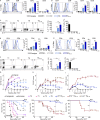
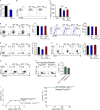
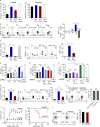

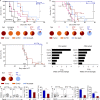



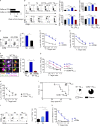
Similar articles
-
Th2 and Tc2 cells in the regulation of GVHD, GVL, and graft rejection: considerations for the allogeneic transplantation therapy of leukemia and lymphoma.Leuk Lymphoma. 2000 Jul;38(3-4):221-34. doi: 10.3109/10428190009087014. Leuk Lymphoma. 2000. PMID: 10830730 Review.
-
Allospecific CD8+ Tc1 and Tc2 populations in graft-versus-leukemia effect and graft-versus-host disease.J Immunol. 1996 Dec 1;157(11):4811-21. J Immunol. 1996. PMID: 8943383
-
Rorc restrains the potency of ST2+ regulatory T cells in ameliorating intestinal graft-versus-host disease.JCI Insight. 2019 Mar 7;4(5):e122014. doi: 10.1172/jci.insight.122014. eCollection 2019 Mar 7. JCI Insight. 2019. PMID: 30694220 Free PMC article.
-
Graft-vs-leukemia activity and graft-vs-host disease induced by allogeneic Th1- and Th2-type CD4+ T cells in mice.Hematol J. 2001;2(2):136-44. doi: 10.1038/sj/thj/6200087. Hematol J. 2001. PMID: 11424006
-
Retention of Donor T Cells in Lymphohematopoietic Tissue and Augmentation of Tissue PD-L1 Protection for Prevention of GVHD While Preserving GVL Activity.Front Immunol. 2022 May 23;13:907673. doi: 10.3389/fimmu.2022.907673. eCollection 2022. Front Immunol. 2022. PMID: 35677056 Free PMC article. Review.
Cited by
-
Pathogen size alters C-type lectin receptor signaling in dendritic cells to influence CD4 Th9 cell differentiation.Cell Rep. 2022 Mar 29;38(13):110567. doi: 10.1016/j.celrep.2022.110567. Cell Rep. 2022. PMID: 35354044 Free PMC article.
-
IL-33 in Tumor Immunity: Nothing to Sneeze At.Crit Rev Immunol. 2018;38(6):453-470. doi: 10.1615/CritRevImmunol.2018026335. Crit Rev Immunol. 2018. PMID: 31002600 Free PMC article. Review.
-
β2-Adrenergic receptor activation on donor cells ameliorates acute GvHD.JCI Insight. 2020 Jun 18;5(12):e137788. doi: 10.1172/jci.insight.137788. JCI Insight. 2020. PMID: 32437333 Free PMC article.
-
Graft-versus-host disease propagation depends on increased intestinal epithelial tight junction permeability.J Clin Invest. 2019 Feb 1;129(2):902-914. doi: 10.1172/JCI98554. Epub 2019 Jan 22. J Clin Invest. 2019. PMID: 30667372 Free PMC article.
-
Targeting the IL-9 pathway in cancer immunotherapy.Hum Vaccin Immunother. 2020 Oct 2;16(10):2333-2340. doi: 10.1080/21645515.2019.1710413. Epub 2020 Feb 10. Hum Vaccin Immunother. 2020. PMID: 32040369 Free PMC article. Review.
References
-
- American Cancer Society 2015. Cancer Facts & Figures 2015. American Cancer Society, Atlanta: https://www.cancer.org/research/cancer-facts-statistics/all-cancer-facts....
MeSH terms
Substances
Grants and funding
LinkOut - more resources
Full Text Sources
Other Literature Sources

